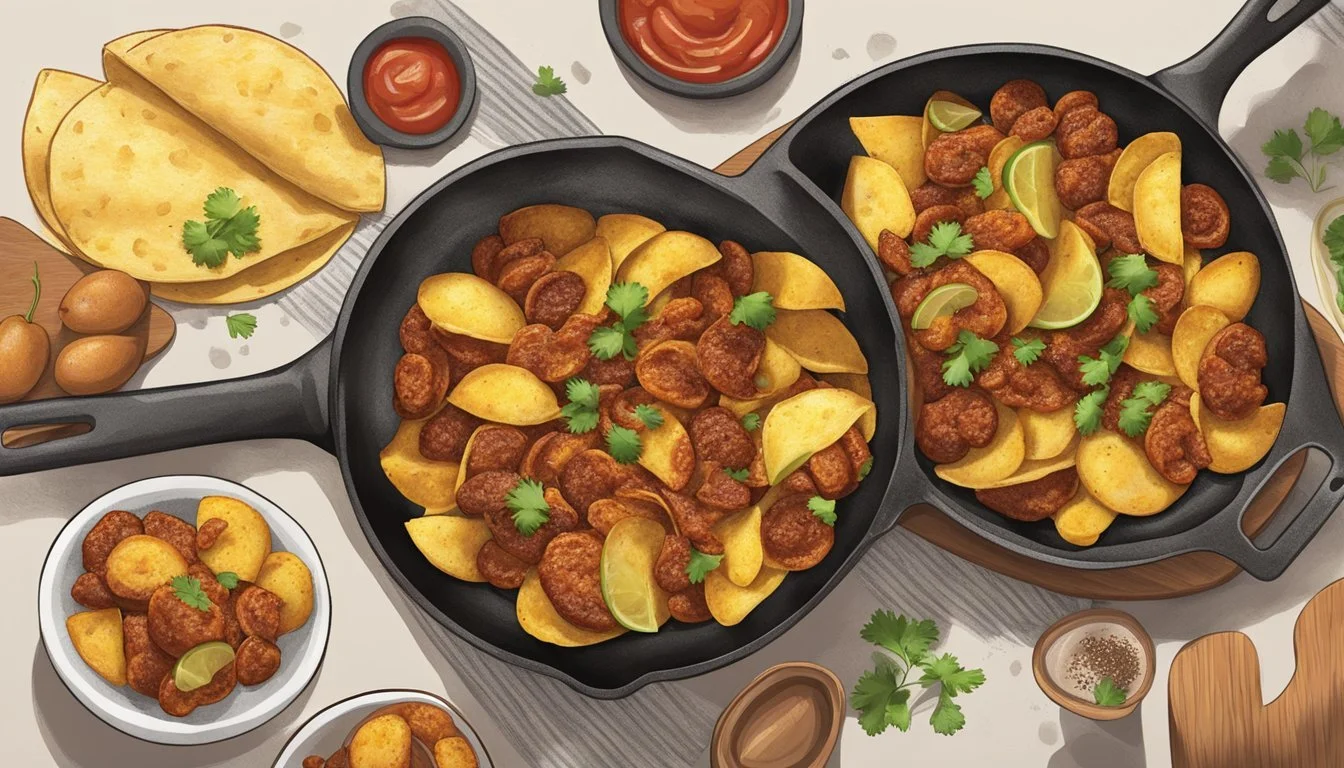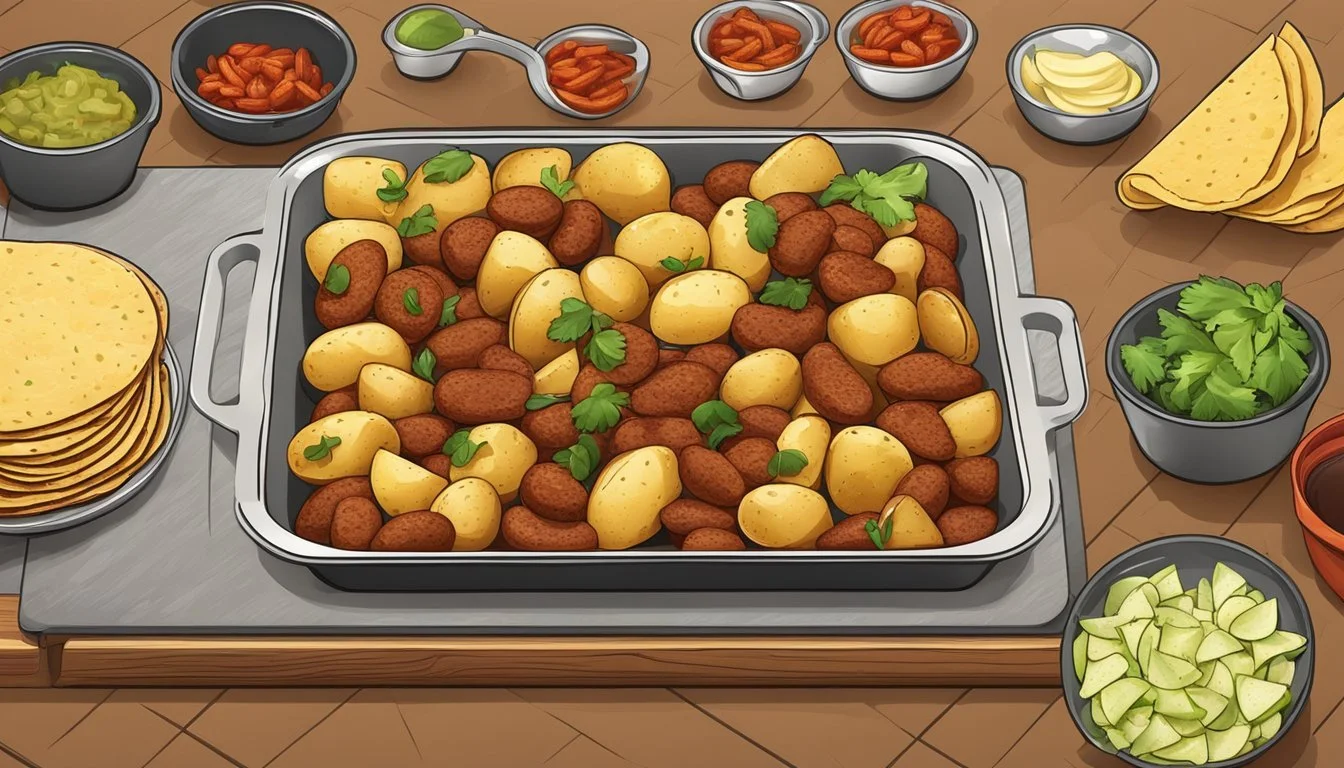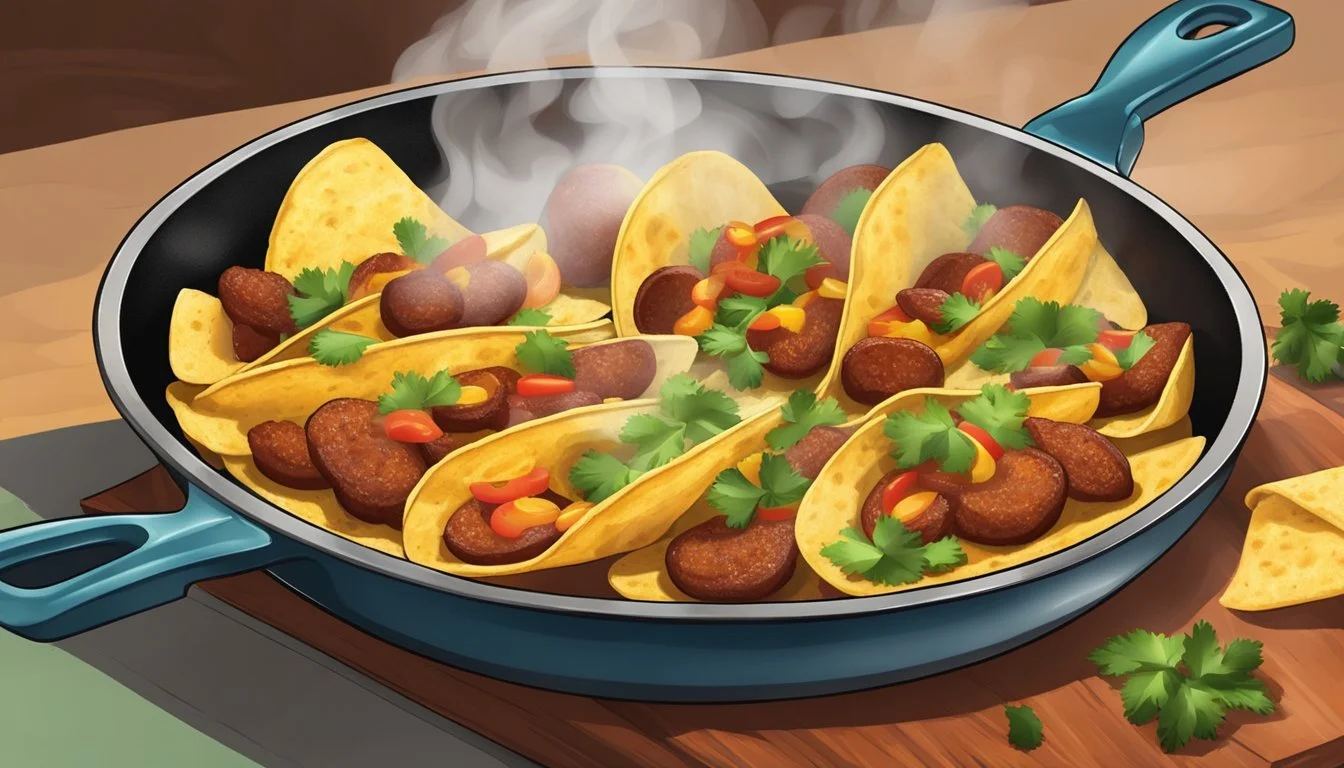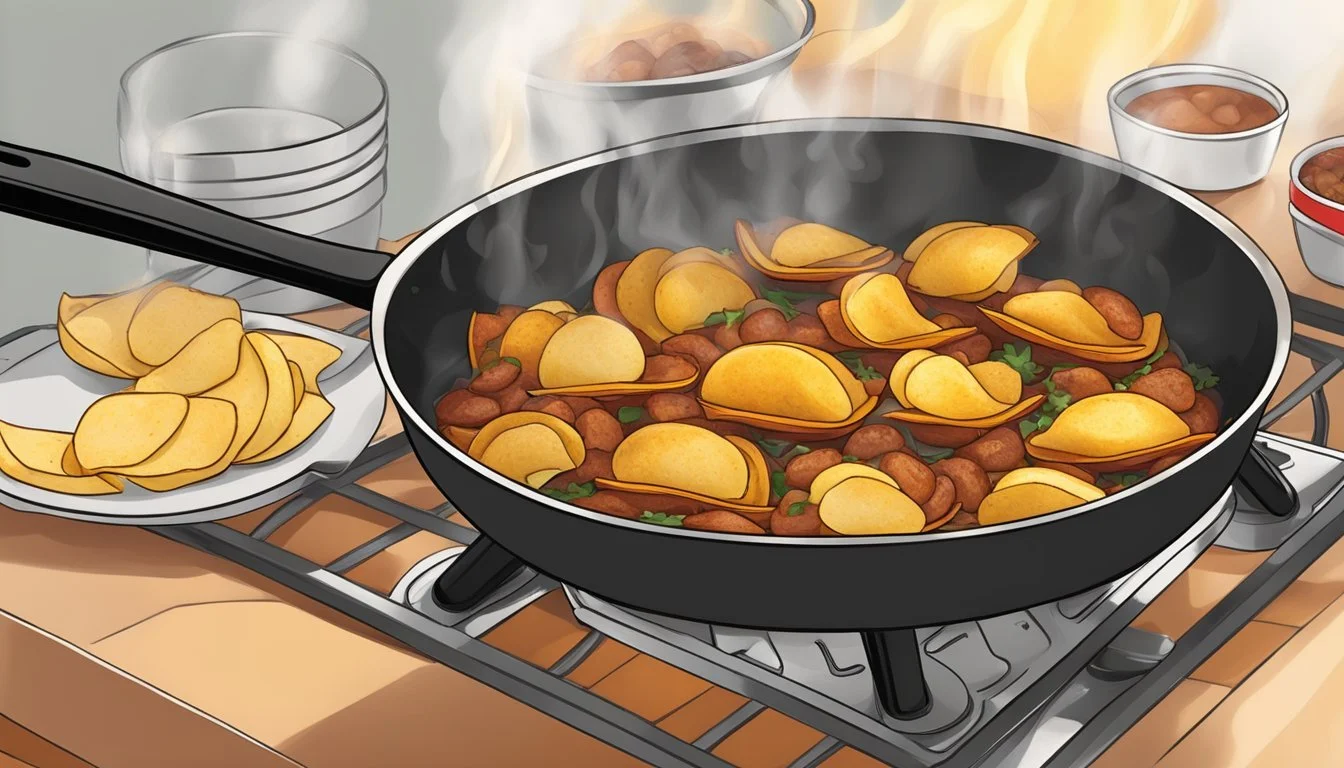Best Way to Reheat Chorizo and Potato Tacos
Ensuring Crispy Potatoes & Flavorful Meat
Reheating chorizo and potato tacos so that the potatoes (What wine goes well with potatoes?) stay crispy and the chorizo remains flavorful is an achievable endeavor with the right technique. Chorizo, a spicy and robust sausage, is packed with bold flavors that can easily become muted if not reheated correctly. Similarly, the texture of the potatoes is integral to the taco experience, and keeping them crispy is essential to capturing that just-made freshness.
Microwave reheating is often a go-to method for its convenience, but it can lead to soggy potatoes and rubbery chorizo. To avoid this, alternative reheating methods such as using a skillet or an oven can be employed. These methods are not only straightforward but also maintain the integrity of the taco's individual components.
Attention to detail is key when reviving leftover tacos. The skillet approach, for example, allows for a controlled environment where the potatoes can re-crisp and the chorizo's oils can once again become fragrant, reinvigorating the dish as a whole. The oven method, on the other hand, provides an even and gentle reheating process that can return the ensemble to its former glory without compromising texture or taste.
Selecting Ingredients for Optimal Reheating
When preparing for reheating chorizo and potato tacos, the quality of ingredients plays a critical role in the end result. Certain ingredients withstand reheating better than others and maintain their desirable qualities in terms of texture and flavor.
Chorizo: For the chorizo, one should choose a type that is flavorful and has a firm texture; this ensures that it retains its taste and doesn't become too oily upon reheating.
Potatoes: For the potatoes, it's preferable to select a variety that is firm and holds up well to cooking and reheating, such as russet or Yukon gold. They should be diced and par-cooked to a golden crispiness before assembling the tacos, using a dash of kosher salt and smoked paprika for seasoning.
Tortillas: As the base of the taco, one must select the right tortillas. Corn tortillas are commonly used for tacos because they provide a sturdy texture and authentic flavor, especially when lightly toasted prior to serving. Flour tortillas can also be used, but they should be of high quality to prevent them from becoming soggy.
Olive Oil: A little olive oil can be brushed on the corn tortillas before heating them up. This prevents drying and adds to the final flavor profile of the taco.
Here's a simple table listing the key ingredients and their use in the reheating process:
Ingredient Selection Tips Reheating Process Chorizo Firm texture, flavorful Heat evenly, avoid drying out Potatoes Firm variety, par-cooked crispy Maintain crispiness, season well Corn Tortillas Slightly toasted for sturdiness Brush with olive oil, heat to preference Flour Tortillas High quality to prevent sogginess Moderate heat to maintain integrity Kosher Salt Enhance flavor Slight sprinkle post-reheating Smoked Paprika Added seasoning for potatoes Use during initial cooking Olive Oil Extra virgin for better taste Use to prevent dry tortillas
Choosing ingredients mindfully sets the stage for reheating chorizo and potato tacos that are satisfying, with crisp potatoes and savory, flavorful chorizo wrapped in a tortilla that complements the filling without overpowering it.
Initial Preparation Before Reheating
Before reheating chorizo and potato tacos, one must ensure the ingredients are prepped correctly to maintain their distinct textures and flavors. This is crucial for achieving the perfect balance between crispy potatoes and a savory, well-seasoned chorizo.
Potatoes: Begin with the potatoes. If they have been refrigerated, bring them to room temperature before reheating. This will help them reheat evenly and prevent sogginess. Cut the potatoes into even sizes for consistent crispness.
Chorizo: Slice the chorizo, or if it’s already in pieces, separate them to ensure they reheat thoroughly. The key is to allow even heating and prevent overcooking, which can toughen the chorizo and diminish its flavor.
Spices and Aromatics: If you're adding spices, a pinch of each should suffice to enhance flavors without overpowering the dish. Freshly chopped onion and garlic (What wine goes well with garlic?) should be prepared if they were part of the initial taco filling for added aroma.
Acidic Components: Lime juice and vinegar should be set aside to add after reheating, as they can help restore the zest and tanginess of the dish without becoming too muted when heated.
Extra Toppings: Avocado and other fresh toppings should be prepared but kept separate, as they are best added after the reheating process to maintain their freshness and texture.
Here's a brief rundown of the preparation steps:
Potatoes: Allow to reach room temperature, then cut uniformly.
Chorizo: Separate for even reheating.
Spices and Aromatics: Prepare a pinch of each chosen spice; chop onions and garlic if used.
Acidic Components: Reserve lime juice and vinegar to be added after reheating.
Extra Toppings: Prep avocado and other fresh toppings, set aside for after reheating.
By following these preliminary steps, one will set themselves up for successfully reheating their chorizo and potato tacos to perfection.
Reheating Techniques
Reheating chorizo and potato tacos requires methods that preserve the crispness of the potatoes and the rich flavor of the chorizo. These specific techniques are tailored to enhance texture and taste without resulting in a soggy or flavorless outcome.
Oven Reheating for Crispiness
For optimal crispness, one should reheat the tacos in an oven. One must preheat the oven to 350°F (175°C). While it is warming up, they should separate the chorizo from the potatoes and place the potatoes on a tray lined with aluminum foil or parchment paper to prevent sticking. It is recommended to lightly drizzle grapeseed oil on the potatoes for an extra crisp. The potatoes should be heated for about 10 minutes, checking frequently to ensure they do not overcook.
Skillet Reheating for Flavor
A skillet is ideal for maintaining the chorizo's deep flavors. One must heat a skillet over medium heat, adding just enough grapeseed oil to coat the bottom. The chorizo should then be added and stirred occasionally until it releases its aromatic oils and regains its characteristic sizzle. To prevent over-drying, they should manage the heat and avoid cooking for too long. Typically, a few minutes is sufficient.
Microwave Reheating with Moisture Control
Reheating tacos that contain both chorizo and potatoes in a microwave is less common, but it can be a quick solution. Here, moisture control is crucial. The filling should be placed in a microwave-safe container, covering it with a damp paper towel to retain moisture. Then, the microwave should reheat the filling in 30-second intervals at 75% power, checking frequently until the desired temperature is reached. Caution should be taken as this method may not retain the crispness of the potatoes as effectively as other methods.
Serving and Presentation
When reheating chorizo and potato tacos, one must ensure the presentation amplifies the dish's inviting flavors. It is recommended to keep tacos on warm tortillas, as they serve as the cozy blanket that wraps around the savory filling. Simply heat the tortillas on a griddle or pan for a few seconds on each side until they are warm and slightly crisp.
Placement of Tacos: Arrange the tacos neatly on a serving platter. A standard approach is to slightly fold the tortillas, allowing the warmed mixture of chorizo and potatoes to nestle comfortably within.
Garnishing:
Sprinkle finely chopped cilantro over the tacos to add a fresh, herby brightness that contrasts the rich, spicy chorizo.
Drizzle a dollop of salsa atop the mixture for a zesty punch.
Place lime wedges on the side; their citrusy zest can be squeezed over the tacos for an extra tangy spark.
Accompaniments: Offer side condiments to elevate the dish:
Sour Cream: A spoonful of sour cream can be added for a creamy, cooling effect.
Cotija Cheese: Crumbled cotija cheese provides a salty tang that balances the potent chorizo spice.
Final Touches: One may also include a small bowl of extra salsa or a spread of guacamole for those who enjoy layering flavors. A confident presentation of chorizo and potato tacos should be both visually appealing and organized, allowing for guests to customize their culinary experience with ease and clarity.
Complementary Toppings and Sides
When serving reheated chorizo and potato tacos, the choice of toppings and sides can enhance the flavors and add texture. Toppings such as crisp lettuce, fresh salsa verde, and creamy guacamole complement the spicy and savory notes of the chorizo, while contributing a refreshing contrast.
Toppings:
Guacamole - A rich, creamy texture and a cool, fresh flavor.
Salsa Verde - Bright and tangy, it cuts through the richness of the meat and potatoes.
Lettuce - Adds a crunchy element to balance the softness of the taco fillings.
Sides: To round out the meal, consider these sides that pair well with tacos:
Side Description Refried Beans Offer a smooth, hearty complement to the tacos. Rice A light, fluffy side that can absorb extra flavors.
If one prefers the tacos to be more traditional and filling, tacos dorados—tacos that are fried until crispy—are a popular variation. They can either be a side or even an alternative way to prepare the chorizo and potato tacos themselves, offering a delightful crunch with every bite.
By selecting the right mix of toppings and sides, one ensures a meal that is not only satisfying but also elevates the core flavors of the chorizo and potato tacos.
Making Chorizo and Potato Tacos from Scratch
To create authentic Chorizo and Potato Tacos, one needs quality ingredients and a sequence of preparation steps. These tacos meld the robust flavors of Mexican chorizo with the earthy essence of crispy potatoes, rounded out by a hint of fresh cilantro.
Ingredients:
500g Mexican chorizo (removed from casing if applicable)
3 medium-sized potatoes, diced
1 tablespoon minced garlic
Fresh cilantro to taste, finely chopped
Corn tortillas for serving
Vegetable oil for frying
Salt to taste
Instructions:
Chorizo Preparation:
Heat a skillet over medium-high heat, no oil is necessary as the chorizo will release its own fat.
Cook the chorizo, breaking apart the ground pork into crumbles as it cooks until it is fully browned. Once done, remove from the skillet and set aside.
Potato Preparation:
In a separate skillet, heat oil over medium-high heat.
Fry potatoes until golden and crispy. Season with salt to taste and add minced garlic for the last few minutes.
Combine potatoes with chorizo once both are cooked, allowing the flavors to meld together. Sprinkle fresh cilantro over the mixture for added freshness.
Assembling the Tacos:
Warm tortillas on a skillet or comal to make them pliable.
Distribute the chorizo and potato mixture evenly among the tortillas.
This recipe captures the essence of these traditional Mexican tacos. The chorizo's spiciness, paired with the garlic's aroma and cilantro's freshness, offers a vibrant taste experience wrapped in a soft tortilla.
Nutrition and Dietary Adjustments
When reheating chorizo and potato tacos, one must consider how to maintain the dish's nutritional value while catering to dietary needs. Yukon gold potatoes, commonly used in this dish, are a good source of vitamin C and potassium. They can be kept crispy by reheating them in an oven or toaster oven, avoiding the microwave which tends to make them soggy.
For those watching their meat intake, soy chorizo is a viable substitute that retains the flavors characteristic of traditional chorizo. It's also lower in fat and calories, making the tacos healthier overall.
In terms of cheese, opting for cheddar provides a source of calcium and protein; however, using a reduced-fat variety or smaller quantities can help those managing their calorie intake without compromising the tacos' taste.
Regarding seasoning, while salt enhances flavor, it must be used sparingly to accommodate those on low-sodium diets. Pepper is a healthier alternative that adds flavor without the health risks associated with high sodium consumption.
Below is a nutritional breakdown for key ingredients:
Ingredient Benefit Yukon Gold Potatoes High in vitamin C and potassium Soy Chorizo Lower in fat and calories; vegan-friendly Cheddar Source of protein and calcium; can use reduced-fat Salt Use minimally; consider potassium-based substitutes Pepper Healthy seasoning option; adds depth of flavor
One must ensure that any adjustments align with specific dietary requirements while also supporting the integrity of the chorizo and potato tacos' distinct flavors and textures.
Advanced Seasoning Tips
When aiming to enhance the flavor profile of reheated chorizo and potato tacos, one must consider the delicate balance of spices. Salt is fundamental; it should be used with precision to amplify the natural flavors without overpowering them. A pinch of salt can make the difference, especially when added just before serving to provide that final flavor boost.
Pepper offers a sharp, woody note, and freshly ground black pepper can greatly enhance the final dish. For a more complex taste, consider incorporating a mixture of different peppercorns such as black, white, green, and pink.
In small quantities, sugar might seem unconventional, but it can subtly round off the spiciness of the chorizo, creating a harmonious flavor profile.
A well-composed spice mix can drastically uplift the tacos. Below is a table outlining key spices and their potential impact:
Spice Impact on Dish Paprika Provides a sweet, smoky flavor and adds a vibrant color. Cumin Brings a warm, earthy note and is essential for an authentic touch. Cayenne Introduces heat; use sparingly to avoid overwhelming other spices. Ancho Chile Powder Offers a mild, smoky heat and complements the chorizo perfectly. Oregano Imparts a subtle, aromatic earthiness, particularly Mexican oregano.
Herbs like coriander leaves (cilantro) add freshness, while a touch of cinnamon or coriander seeds can provide unexpected, yet delightful, background notes. Each spice should be used judiciously to avoid muddling flavors and to keep each note distinguishable.
To achieve the best results with these seasonings, they should dry-toast spices such as cumin and coriander seeds before grinding to unlock their oils and full aroma. Notably, a chef must remember that reheating can intensify the flavors, so they should season with a lighter hand than they might when cooking fresh.
Preserving Leftovers
When one has enjoyed a flavorful meal of chorizo and potato tacos, ensuring the leftovers maintain their quality is essential. Chorizo, due to its high fat content, can remain potent in flavor and safe to eat when properly stored. Leftover tacos, particularly with their varying components require careful handling to preserve their textures and tastes.
Potatoes, a primary ingredient, need to be cooled promptly to prevent sogginess. When storing tacos, it's advisable to deconstruct them. Tortillas should be wrapped in aluminum foil or placed in a sealable bag to prevent air exposure which can dry them out. The potatoes and chorizo should be stored separately in airtight containers.
For refrigeration, it's essential to adhere to the following guidelines:
Chorizo: Place in an airtight container or wrap tightly with plastic wrap. Can be refrigerated for up to a week.
Potatoes: Ensure they are at room temperature before storing in a container with a paper towel to absorb excess moisture.
Tortillas: Store at room temperature in a dry area if consuming within 24 hours, or refrigerate wrapped in foil or sealed in a bag to maintain pliability.
Below is a simple table to summarize:
Ingredient Storage Method Location Chorizo Airtight container/plastic wrap Refrigerator Potatoes Container with paper towel Refrigerator Tortillas Aluminum foil/plastic bag Room temp or Refrigerator
One should be cautious to avoid cross-contamination between the cooked and raw food items. Appropriate storage will keep leftovers safe and appetizing for subsequent meals.
Thematic Variations for Different Occasions
When catering to different events, chorizo and potato tacos can be tailored to suit the theme with a variety of toppings and sauces. For a zesty Taco Tuesday, adding a squeeze of lime brightens the flavors. A simple table setup with limes cut into wedges allows guests to add their desired amount of tang.
For a more savory experience, a sprinkle of dried oregano over the tacos before reheating can amplify the herby notes. One can also consider a light drizzle of apple cider vinegar to the potatoes as they reheat, ensuring the zing complements the rich chorizo.
Occasion Suggested Topping Sauce Suggestion Casual Gatherings Fresh Cilantro, Diced Onions Tomatillo Salsa Summer BBQs Slices of Avocado, Pickled Red Onion Spicy Hot Sauce Taco Tuesday Radish Slices, Crumbled Queso Fresco Lime Wedges on the Side Autumn Events Roasted Corn, Black Beans Smoky Chipotle Crema
For hot sauce enthusiasts, a selection of hot sauces can cater to varying heat preferences. Tacos can be sprinkled with ground cumin and ground coriander, which will adhere well to the chorizo's natural oils, allowing the spices to bloom during the reheating process.
Regardless of the occasion, it's important to maintain the integrity of the crispy potatoes and flavorful chorizo. Therefore, the reheating method should ensure that the potatoes remain crisp while the chorizo stays succulent. Suggested thematic variations consider the harmony of flavors and the overall experience of enjoying chorizo and potato tacos.
Cultural Significance and History
Chorizo and potato tacos are a staple in Mexican cuisine that combines the vibrant flavors of Mexican chorizo with the earthy tones of potatoes, typically served on corn tortillas. They offer a textured experience, where the spiciness of the chorizo is balanced by the starchy softness of the potatoes.
Mexican vs. Spanish Chorizo
Mexican chorizo is made with fresh meats and local spices, including chilies, which give it a characteristic red color and robust flavor. It's used as a versatile ingredient in tacos and other dishes.
In contrast, Spanish chorizo is a cured sausage, often made with smoked pork, pimentón, and garlic, rendering it firmer and suitable for slicing.
Both types of chorizo have a rich history intertwined with cultural influences and regional tastes. Spanish chorizo is steeped in traditions dating back to the Roman Empire, while Mexican chorizo is a result of cultural fusions post the Spanish conquest of the Aztec Empire.
Tacos, a culinary form that's a cornerstone of Mexican food (What wine goes well with Mexican food?) culture, likely originated with Mexican silver miners in the 18th century. They wrapped their meals in corn tortillas for practicality. Tacos have evolved over time, allowing for a variety of fillings, including the flavorful chorizo and potato combination.
This taco variant captures the essence of Mexican cooking - a cuisine that values freshness, flavor, and community. In Mexico, tacos are more than food; they are a part of daily life and celebrations, representing a rich tradition that has been passed down through generations. Chorizo and potato tacos not only satisfy hunger but also carry the history and heart of a nation's kitchen.






